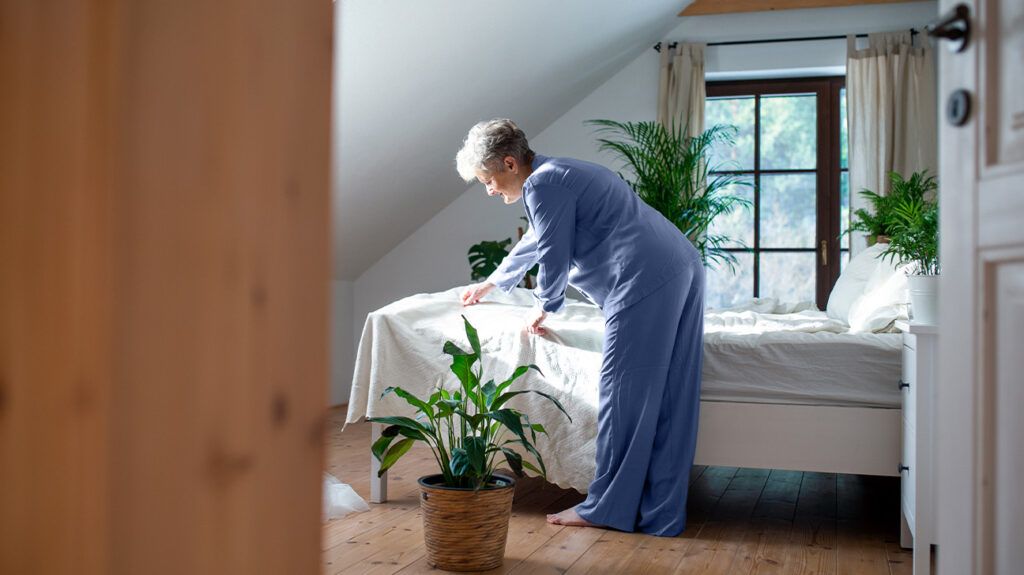For many, the best sleep position for sleep apnea is the side. However, some people find it helpful to sleep on the stomach or with the upper body elevated.
Sleep apnea is a serious sleep disorder involving frequent pauses in breathing during sleep. These interruptions can occur hundreds of times, preventing the body from reaching the deep, restorative stages of sleep. The resulting sleep deprivation can lead to various health issues, from chronic fatigue and memory problems to more severe conditions such as heart disease and diabetes.
While medical interventions, such as continuous positive airway pressure (CPAP) therapy and surgery, are options, adjusting sleeping positions is a simple method that can help. Sleeping on the side or stomach may ease symptoms.
Continue reading to learn more about the best sleeping positions for sleep apnea and other treatment methods.

The position in which a person sleeps can either worsen or ease the symptoms of obstructive sleep apnea (OSA) by affecting the alignment and openness of the airway. While some positions can help maintain an open airway and reduce the likelihood of interruptions, others may contribute to airway obstruction, worsening the condition.
For example, supine-related OSA is a type of sleep apnea that is more likely to occur when a person sleeps on their back. In this position, known as the supine position, the airway is more prone to blockage, especially around the soft palate and epiglottis (the flap that covers the food pipe), leading to breathing interruptions. When lying on the back, breathing problems occur twice as often as sleeping on the side or stomach.
Therefore, experts may recommend that people sleep on their side to help maintain a more open airway, reducing the frequency and severity of apnea events. That said, improvements may be structure-specific. This means the effectiveness of a position depends on factors such as the shape of the airway, the position of the tongue, and the overall body structure.
What is sleep apnea?
Sleep apnea is a condition where a person’s breathing repeatedly stops and starts during sleep. There are three main types of sleep apnea:
- obstructive sleep apnea (OSA)
- central sleep apnea (CSA)
- complex sleep apnea syndrome, which is a combination of the other forms
OSA is the
Learn more about sleep apnea.
Experts recommend sleeping on the side for many people with OSA. It particularly benefits those with supine-related OSA, where symptoms worsen when lying on the back.
Clinicians
These options are cost-effective and may result in better adherence compared to CPAP therapy, especially in those with mild to moderate OSA.
Stomach sleeping may be helpful for some people with sleep apnea as it naturally helps keep the airway open and reduces the likelihood of airway obstruction. It may reduce episodes of restricted or stopped breathing and improve oxygen levels in the blood. It may also minimize position-dependent snoring. However, it can be problematic.
The position can force the neck to twist, which can misalign the spine and lead to or worsen back pain. Additionally, the added pressure on spinal tissues can cause issues. For those who prefer sleeping on their stomach, a firmer mattress can help keep the spine properly aligned by elevating the hips.
Ultimately, sleeping on the stomach might be the best option for some individuals if it allows for better rest.
Sleeping on the back or supine is generally not advisable for those with sleep apnea. In this position, gravity can cause the tongue and soft tissues in the throat to collapse backward, obstructing the airway and worsening symptoms.
However, some individuals may find it difficult to avoid this position, so using special pillows to raise the head might be helpful.
Managing sleep apnea involves more than adjusting sleeping positions. Clinicians
It is also crucial to address any underlying health conditions contributing to symptoms and attend regular follow-ups with healthcare professionals.
Josh’s story: The best positions for sleep apnea
“Living with sleep apnea has certainly been a challenge. When untreated, it disrupts my sleep, leaving me feeling fatigued and less alert during the day. Over time, I’ve realized how crucial proper sleep positioning is in mitigating these effects and improving my overall well-being.
Sleeping on my side has been the most effective for me. This position helps keep my airway open, minimizing interruptions in breathing. I use a body pillow to maintain this posture throughout the night, preventing me from rolling onto my back, which tends to worsen my symptoms. Additionally, elevating my head with a wedge pillow further reduces airway obstruction and helps with acid reflux.
My biggest tip is to focus on sleep positioning. Whether it’s side sleeping or elevating the head, these small adjustments can make a huge difference in managing symptoms. Investing in supportive tools, such as a body pillow or adjustable bed, is also helpful. Finding what works for your body is key.”
Treatment for sleep apnea
Moderate to severe cases often require CPAP therapy. This treatment requires the individual to wear a mask connected to a machine that delivers a continuous air stream. This helps keep the airway open throughout the night, preventing interruptions in breathing during sleep.
In some instances, doctors may recommend surgery to remove obstructions or adjust the airway structure.
With appropriate management and treatment, individuals with sleep apnea can significantly improve their sleep quality and reduce the risk of associated health problems.
However, in people requiring CPAP, there can be issues with adhering to treatment. Nearly
Sleep apnea is a condition that can severely affect sleep quality and overall health. Adjusting sleeping positions, such as sleeping on the side or stomach, can help ease symptoms. However, sleeping on the back can worsen the condition.
Other treatments, such as continuous positive airway pressure (CPAP) therapy and lifestyle changes, are crucial in managing sleep apnea and improving long-term outcomes.
